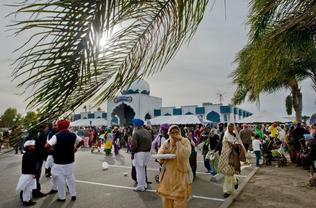Yuba City, California: Amandeep Chanju was holding his 3-month-old son in his arms as he watched the steady procession of floats blaring Sikh hymns, prayers and chants pass Sunday.
“I like everything,” said Chanju, 34, of Santa Rosa, who was standing with his family along the road, not far from the Sikh temple in Yuba City. “It’s my religion, and I like being part of this with different people from different religious communities.”
Chanju was among the estimated 80,000 to 100,000 people who watched or walked among 45 floats in the 34th annual Sikh parade, which wound through 4 1/2 miles of city streets. The Yuba City parade is considered the largest in the United States, drawing participants and onlookers from around the world.
The parade, called Nagar Kirtan, marks the end of the three-day Guru Gadee Diwas festivities that celebrate the inauguration of the Siri Guru Granth Sahib, the holy scripture of Sikhism.
“It is the day that we launched the Granth,” said Sahib Singh, a priest of the Sikh Temple in Yuba City, also known as the Tierra Buena Gurudwara. “We take the word out into the city so everyone can see the Guru Granth.”
The Sikh scripture is placed on a float, which leads the procession. Traditionally, the float is preceded by the Panj Piare, or the Five Beloved of the Guru, who are dressed in saffron or orange robes. Orange is the color of peace in Sikhism.
Along the parade route, a number of booths offered free food and drink. The free provisions are a reminder of a deed of the first Sikh guru, according to Chanju.
“When he was 9 years old, his father gave him 20 rupees to buy food for the saints, and he went and bought food for the poor people,” he said.
Karmjit Gill, 31, of Fresno was eating from a plate of saag (a spinach and mustard dip) and makhi roti (corn tortilla) at one of the stands along the parade route. She came with her family – her husband, Awtar Gill, 35; two daughters, Komal, 7, and Puneet, 5, and her son, Gurman, 3 – all wearing traditional, colorful Indian garb.
“It’s (God’s) festival and we came to have fun,” said Karmjit Gill, who wore a brilliant blue and silver sari. “This is the biggest one (parade), and I like all the floats and that people get together.”
Nav Kang, 15, from British Columbia, Canada, had a slightly different reason for walking in the parade. She had come down with 20 other Canadian Sikhs to be the last “float” in the parade. They walked alongside a black van which bore a sign with a website address: www.waheguru.ca.
Kang and a number of others dressed in white tunics and pants, with orange turbans and sashes, were passing out free CDs to people along the parade route.
“We want to spread the knowledge of Sikhism,” she said. “A lot of people ask about us and take the CDs.”
She marveled at the differences between the parades in Yuba City and Surrey. “It’s amazing to see that it’s so big and so open,” she said. “There are a lot of people here who wear turbans (as a sign of their faith).”
Kang said she also learned more about Sikh history by just looking at some of the floats in the Yuba City parade. One float had images, names and dates of notable gurus in Sikh history painted on one side of the truck.
Rae Lee, 63, of Magalia had come with her husband, Paul Lee, 65, to watch the parade for the first time. They were enjoying Popsicles that they got from a Mexican ice cream vendor.
“We like learning about other cultures,” she said, while standing near the first turn for the parade. “It’s amazing. I think it’s a huge gift they are giving to the city.”
The couple said they enjoyed the colors and the sounds from the parade. “You definitely think you’re in India,” said Paul Lee.
Source: Sacbee.Com
 Sikh Sangat News Celebrating Sikh culture and sharing Sikh voices
Sikh Sangat News Celebrating Sikh culture and sharing Sikh voices

